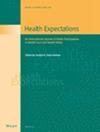Reporting on a Partnership to Co-Design a Digital Health Intervention With Young People Who Have Experienced Technology-Assisted Sexual Abuse
Abstract
Introduction
While Patient and Public Involvement and Engagement (PPIE) is a key element of research best practice across healthcare, the co-design process for digital health interventions (DHIs) remains under-reported. This study explores the co-design process of the i-Minds DHI, developed for young people exposed to technology-assisted sexual abuse (TASA), with a focus on advancing PPIE in DHI development. The research team collaborated with a Lived Experience Advisory Group (LEAG) to co-design the intervention, detailing activities, experiences, benefits, challenges and priorities identified throughout the process.
Methods
The study involved four participatory co-design workshops and focus groups with LEAG members. Key activities included identifying key features of the app design and content, gathering feedback on prototypes, discussing priorities for the app's function and trial design, and refining the language and content of user-facing materials. Features were prioritised using the MoSCoW method.
Results
Recruitment of LEAG members, facilitated by the Marie Collins Foundation, emphasised the importance of involving trusted organisations when addressing sensitive topics like TASA, as many young people do not initially recognise themselves as victims. Key findings highlighted the importance of clear communication, structured processes (e.g., Terms of Reference) and financial remuneration for members to promote equity of opportunity. Agile development methods enabled iterative refinement of the app, integrating user feedback in real time. However, time and budget limitations constrained the integration of all desired features, with the MoSCoW method providing transparency in decision-making.
Conclusion
We offer recommendations for effective PPIE, including prioritising lived experience input early in research, allocating sufficient resources and fostering transparent communication. Despite challenges, such as limited diversity within the LEAG and remote meeting formats, PPIE was considered meaningful by members. This study provides a valuable framework for co-designing DHIs and improving inclusivity in PPIE efforts, particularly in sensitive research areas like TASA.
Patient and Public Contribution
This study was supported by a LEAG, which undertook the role of partners and was involved in study design, ethical considerations, recruitment, content revision and project oversight. Authors included lived experience members and people with intersecting lived experience and research identities.


 求助内容:
求助内容: 应助结果提醒方式:
应助结果提醒方式:


